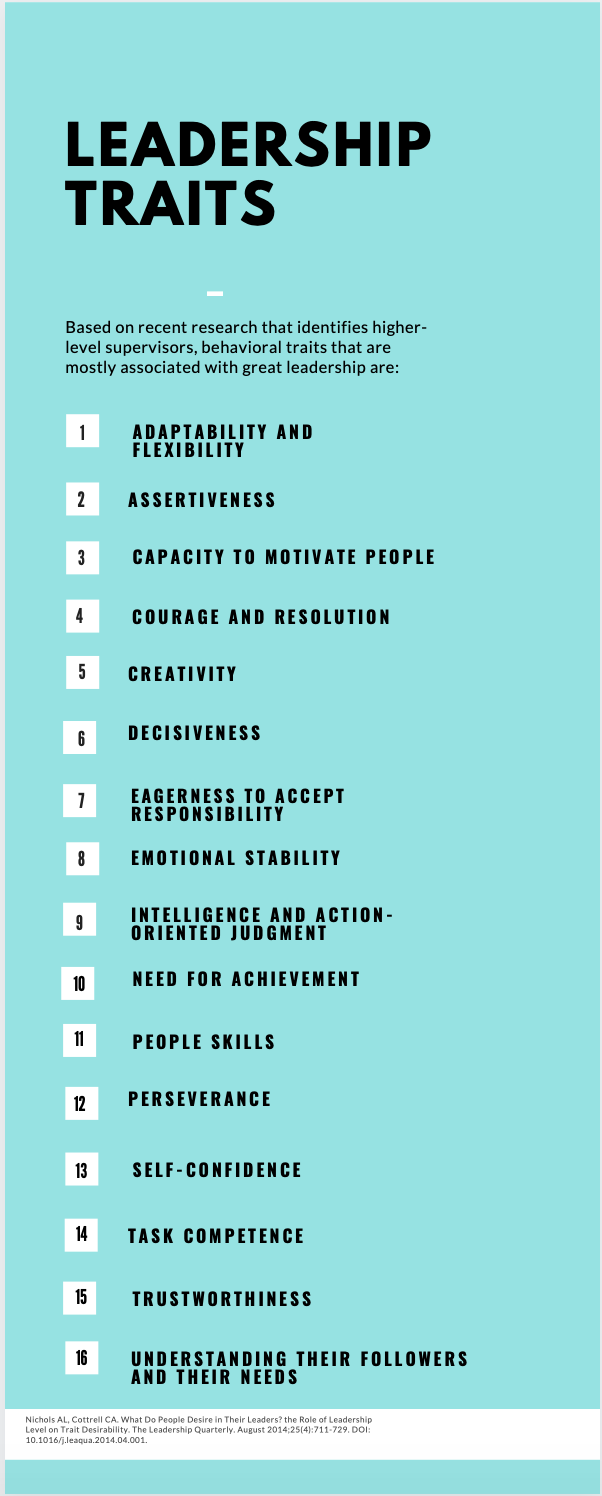
Leadership: A Born Talent Or A Learned Set Of Skills?
It is also true that just possessing some of these traits does not automatically make a leader; indeed, situational variables would allow leadership skills to appear when the right opportunity emerges.
Leaders are made, they are not born. They are made by hard effort, which is the price which all of us must pay to achieve any goal that is worthwhile." (Vince Lombardi)
Welcome back, ExO readers. Ready to prepare your chessboard to become a great leader? Let’s start the game!
In today’s article from our new series on leadership 4.0 and digital transformation, we will talk about leadership traits, styles, and the most known theories behind them. Moreover, we will try to discover whether anyone can potentially become a leader just by acquiring and learning a precise set of skills, or whether leadership should be assumed as a gifted talent, gave at birth. More recent key elements and styles that characterize leadership theories will be discussed [1,2], likewise, the role of the leader, as an “influencer” capable of achieving any goals and generating exponential changes, will be presented. This article means to be the starting point when understanding, predicting, and controlling the role and qualities of evolving into successful leaders.
The root of leadership: a matter of style?
Nowadays we hear pretty much about leaders and leadership, but what does that mean?
Leadership can be both a research area of study and a set of skills about the ability of a single individual, group, or organization to “lead” and “influence” other individuals, groups, communities, or entire enterprises.
Although the term leadership is very old, actually its etymology is relatively modern in which the first known use can be found back to 1821 when “leader” was combined with the suffix “ship”. However, the word leader has ancient roots, from the Old English lædere (“one who leads”), and lædan (“to guide”). When thinking about Latin, the closest word is ducere (“to lead”) and in the modern Romanian language, leading and leadership can be related to conducere (“to conduct”). We can see that the etymology of the words leads, leader, and leadership are very complex and their meaning can vary across ages.
If leader and leadership refer to the role of guiding toward a goal, different styles of leading should be considered. Indeed, a leadership style is a particular method of giving direction, actuating plans, inspiring and motivating people and communities [3]. Different styles were proposed and identified by leaders in several areas (e.g., political, business, military) and a few studies on leadership were also conducted in the military field [4], in which a holistic view of leadership has mostly emerged; physical strength, confidence, resilience, and intellectual capacity. Referring to the leadership style to a leader’s characteristic behaviors while guiding, managing, and motivating a group, has the effect of generating and inspiring movements and social changes. Creator of innovation, leaders may differ in their own leadership style. Thus, different theories would allow us to well identify these unique styles.
Great leadership comes with great traits
Is it possible to predict a leader’s success based on characteristic traits? The trait theory of leadership aims to identify several personality traits that are recurrent and associated with successful leaders when facing different situations. In this line, the nature of effective leadership has been explored; a born characteristic or a learned set of skills.
Originally, Carlyle supported the idea that the ability to lead is a gift given at birth, that cannot be developed through life; an inheritable trait. Hence, Carlyle’s theory was reinforced from the hypothesis that particular traits generate specific patterns and that these patterns would emerge consistently among different situations, explaining why leaders are born with these recurrent traits. Moreover, from the 1940s to the 1970s, psychologists debated this trait-based theory and explored further the topic in which, R. M. Stogdill proposed a novel frame considering leadership as the product of the interaction between an individual and his/her own environment (social situation), thus not the outcome of a pre-defined range of personality traits [5]. Lastly, in the 1980s several other key aspects were identified by Kouzes and Posner in which credibility, honesty, forward-looking, and competency were recognized as characteristic and stable leadership skills [6].
Accordingly, researchers established several traits that characterize high-quality leaders [7] as reported in the infographic below.

Interesting is the fact that researchers found that just a few of these traits would distinguish leaders from followers and that these traits would be most associated with effective communication, self-confidence, extroversion, and height [8]. It is also true that just possessing some of these traits does not automatically make a leader; indeed, situational variables would allow leadership skills to appear when the right opportunity emerges. However, others have also supported a contingency approach in which traits may be more effective in specific situations leading to different opinions regarding the variability of these traits among situations predicting or not a success. Lastly, leadership traits inheritance [9] remains a controversial topic, especially when dealing with global socio-demographic and economical changes that enable or limit the potential of a person to lead, as well as, based on the online and offline connection in the digital era.
Different styles to identify the “how” of greatness
In 1939, Kurt Lewis and his group of psychologists established a set of leadership styles [10], representing a reference study for more recent research. Lewis identified three main leadership styles:
- Authoritarian (autocratic) leadership is focused on command and control, clearly establishing who is the leader and the group members. Decisions are made exclusively by authoritarian leaders while defying a direct expectation for “what, how, when” something needs to be done, leaving less space for creativity or democratic opinions. However, this style of leadership is the most effective when situations require rapid decisions and actions or the leader possesses the highest knowledge in the group, although this approach results generally dysfunctional due to hostilities generated between the leader and the group members.
- Participative (democratic) leadership is focused on encouraging participation, welcoming opinions in a shared decision-making process. A democratic leader evaluates the creativity, motivation, and engagement of each group member, although the productivity might be less but with higher quality.
- Delegative (laissez-faire) leadership gives little guidance to the group leaving them in complete autonomy when making decisions. Despite the fact that this style allows higher freedom, it can be effective in situations in which group members are experts and qualified. Lack of motivation, responsibility and role assignments can lead to mistakes, slow progress, and low productivity.
Bass and Bass [11] investigated these styles, considering autocratic leadership as less effective, generating stress and conflicts in the group, although this approach would be needed when establishing order, rules, standards, and clear directions. On the other side, democratic leadership is viewed as the most desirable in which empathy among members, shared responsibility, decisions, and roles are recognized.
Transformational, transactional, or situational?
In addition to Lewis’s leadership styles, further research integrated with novel approaches. Among these:
- Transformational leadership, initially reported in the 1970s and later investigated by Seitzer and Bass (1990) [12], is considered the most effective style in which leaders are able to motivate, guide, and inspire group members toward positive changes. Through emotional intelligence, passion, and engagement, transformational leaders aim to support the group in achieving goals, as well as, empowering their personal capacities resulting in higher performance and group fulfillment [13].
- Transactional leadership defines the relationship between the leader and group members based on a transaction, in which followers are required to perform tasks in return for compensation (reward). Although this leadership approach gives clear direction, supervision, and defined roles, it prevents group members from developing their own creativity [14].
- Situational leadership, initially proposed by Hersey and Blanchard (1969) [15] focuses on evaluating the effect of situations and the environment on leadership. This model includes four styles: telling people what do to, convincing (selling) followers about a leader’s idea, allowing people to participate in the process of making decisions, and delegating the role of making decisions. Furthermore, the model has been further improved including four additional leading styles [16]: directing (giving orders but also assistance and guidance), coaching (giving orders but also strong support), supporting (giving support but lack of precise direction), and delegating (giving limited support and guidance).
Theories are needed to explain the “why” of greatness
In the next article of this series, different leadership theories developed over the last century will be discussed to understand why certain people become successful leaders. Moreover, the five key elements of leadership in determining transformative changes inside organizations and communities will be presented. Lastly, a few comments from Brian Tracy will follow to discover which top qualities are need to transform a good leader into a great one!
"The single biggest way to impact an organization is to focus on leadership development. There is almost no limit to the potential of an organization that recruits good people, raises them up as leaders, and continually develops them." (John Maxwell)

References:
- DeRue, D., & Ashford, S. (2010). Who will lead and who will follow? Social process of leadership identity construction in organizations. Academy of Management Review, 35(4), 627–647.
- Oberer, B. & Erkollar, A. (2018). Leadership 4.0: Digital Leaders in the Age of Industry 4.0. International Journal of Organizational Leadership, 7, 4, 404-412. DOI: 10.33844/ijol.2018.60332
- Kotter, John P., 1947- (2001). What leaders really do. Harvard Business School Pub. Corp. ISBN 1-57851-382-0. OCLC 57299317.
- Lindsay, Douglas. "Shared Leadership in the Military: Reality, Possibility, or Pipedream?". ResearchGate.
- Oakleaf L. Trait theory of leadership. Organization and Administration in Recreation, Sport and Leisure Management, Missouri Western. November 2016.
- Jim Kouzes and Barry Posner: The Authors of The Leadership Challenge. The Leadership Challenge. November 2019.
- Nichols AL, Cottrell CA. What Do People Desire in Their Leaders? the Role of Leadership Level on Trait Desirability. The Leadership Quarterly. August 2014;25(4):711-729. DOI: 10.1016/j.leaqua.2014.04.001.
- Jiang J, Chen C, Dai B, et al. Leader emergence through interpersonal neural synchronization. Proc Natl Acad Sci USA. 2015;112(14):4274-9. PMID:25831535
- Kumar S, Adhish VS, Deoki N. Making sense of theories of leadership for capacity building. Indian J Community Med. 2014;39(2):82-6. doi:10.4103/0970-0218.132721
- Lewin K, Lippitt R, White K. Patterns of aggressive behavior in experimentally created “social climates”. J Soc Psychol. 1939;10(2):271-301.
- Bass BM. The Bass Handbook of Leadership: Theory, Research, and Managerial Applications. 4th Ed. Simon & Schuster; 2009.
- Seltzer, J., & Bass, B. M. (1990). Transformational Leadership: Beyond Initiation and Consideration. Journal of Management, 16, 693-703. http://dx.doi.org/10.1177/014920639001600403
- Choi SL, Goh CF, Adam MB, Tan OK. Transformational leadership, empowerment, and job satisfaction: The mediating role of employee empowerment. Hum Resour Health. 2016;14(1):73. doi:10.1186/s12960-016-0171-2
- Hussain S, Abbas J, Lei S, Haider MJ, Akram T. Transactional leadership and organizational creativity: Examining the mediating role of knowledge sharing behavior. Cogent Bus Manag. 2017;4(1). doi:10.1080/23311975.2017.1361663
- Hersey P, Blanchard KH. Life cycle theory of leadership. Training and Development Journal. 1969;23(5).
- Blanchard KH, Zigarmi P, Drea Zigarmi. Leadership and the One Minute Manager: Increasing Effectiveness Through Situational Leadership. William Morrow, An Imprint Of HarperCollins; 2013.

ExO Insight is a written word publication for exponential insights from thought leaders including members of our OpenExO community. We tell stories of transformation while hoping to inspire and drive change in the world for positive impact. If you don't want to miss an article, be sure to subscribe here.
ExO Insight Newsletter
Join the newsletter to receive the latest updates in your inbox.









